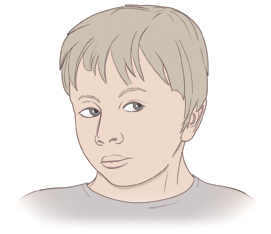Nystagmus
Nystagmus is when one or both eyes move abnormally. This eye movement can't be controlled.
Eye movements with nystagmus
With nystagmus, eye movements are quick and happen again and again. They may happen all the time (continuous). Or they may happen suddenly and then stop (paroxysmal). These movements can’t be controlled (involuntary).
The direction of the eye movements can be:
-
Side to side (horizontal)
-
Up and down (vertical)
-
Around in a circle (rotary)
-
One eye goes up while the other goes down (see-saw)
-
Any combination of the above
Because of these abnormal movements, the eyes can’t focus well. This affects vision. To see better, people with nystagmus may hold their head in an abnormal position. They may tilt or turn their head. They do this to get to the null point. That is the angle of vision where the person’s eyes move the least. It’s also the most visually comfortable position. Nodding the head may also reduce eye movement.
 |
| A person with nystagmus may hold his or her head in an unusual position to access the “null point.” This helps reduce abnormal eye movement and improve vision. |
Types and causes of nystagmus
There are two main types of nystagmus: congenital or acquired. Each type can have one or more causes. But the exact cause is often unknown. Most cases of nystagmus are lifelong (permanent).
Congenital (or infantile) nystagmus. This is the most common type. A child is born with it. Symptoms appear soon after birth. It may be caused by:
-
Sensory problems. Vision problems, such as a clouded lens (cataracts) or increased pressure in the eye (glaucoma), may cause nystagmus. Another possible cause is a problem with the light-sensing layer of nerves in the back of the eye (the retina). Or there may be a problem with the nerve that connects the eye to the brain (the optic nerve).
-
Nervous system problems. Problems in the brain can cause nystagmus. This is because the brain and the eyes must work closely together for good vision.
-
Other conditions. Disorders linked to nystagmus include a lack of pigment in the skin and eyes (albinism). Another cause may be not having a colored part (iris) in the eye (aniridia).
Acquired nystagmus. This type happens later in life. There are a few possible causes, including:
-
Alcohol use
-
Some medicines (most often anti-seizure medicines)
-
Inner ear disorders, such as Meniere disease
-
Brain disease, such as multiple sclerosis or a brain tumor
-
Stroke
-
Head injury
Symptoms of nystagmus
Symptoms depend on the type of nystagmus:
-
Congenital. Vision may be affected. But eye movement may not be a problem.
-
Acquired. Eye movement may be more obvious and annoying. Blurry vision may happen. Depth perception may also be affected. This can harm balance and coordination. It can also cause dizziness.
Diagnosis of nystagmus
A healthcare provider or eye doctor will take a health history. A physical exam will be done, including an eye exam. Certain tests may also be done, such as:
-
CT scan or MRI of the head. These imaging tests create detailed pictures of the brain. They can show any swelling, stroke, or tumors that may be causing nystagmus.
-
Electroretinography (ERG). This tests how well the retina is working.
-
Vestibular testing. This checks for problems in part of the inner ear (the vestibule). This part of the ear helps control eye movement.
-
Lab tests. These check for infections, an imbalance of chemicals in the body, and tumors.
Treatment of nystagmus
Children should see a pediatric eye care provider. If your child needs surgery, you may be referred to a pediatric ophthalmologist who treats this condition.
In most cases, treatment helps reduce symptoms. But it may not fully get rid of them. Treatment depends on the cause of the nystagmus. There are 5 main treatment options:
-
Treating the underlying cause. Sometimes, there is a clear cause that can be addressed. For instance, a cataract may be treated, or a tumor may be removed. If nystagmus is caused by a medicine, the medicine may be stopped. When these underlying causes are treated, nystagmus may be cured.
-
Treating related vision problems. Contact lenses or eyeglasses can help correct problems such as nearsightedness and farsightedness. Special prisms may be used to adjust eye gaze. This helps to get the best possible vision and reduce symptoms.
-
Medicines. These can help reduce eye movement and vision loss.
-
Botulinum toxin shots (injections). These weaken eye muscles and may help reduce symptoms.
-
Surgery. This procedure changes the position of the muscles that move the eyes. It doesn't cure nystagmus. But it may reduce the amount a person must turn their head to see well.